
Margaret Brown, posthumously known as the "Unsinkable Molly Brown", was an American socialite and philanthropist. She was a survivor of the RMS Titanic, which sank in 1912, and she unsuccessfully urged the crew in Lifeboat No. 6 to return to the debris field to look for survivors.

Violet Constance Jessop was an Argentine ocean liner stewardess and nurse in the early 20th century. Jessop is most well known for having survived the sinking of both the RMS Titanic in 1912 and her sister ship the HMHS Britannic in 1916, as well as having been onboard the eldest of the three sister ships, the RMS Olympic, when it collided with the British warship HMS Hawke in 1911.
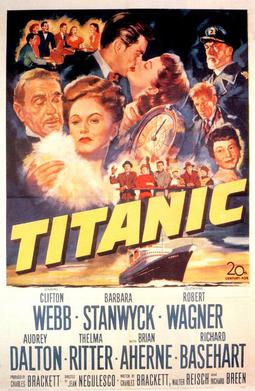
Titanic is a 1953 American drama film directed by Jean Negulesco and starring Clifton Webb and Barbara Stanwyck. It centers on an estranged couple and other fictional passengers on the ill-fated maiden voyage of the RMS Titanic, which took place in April 1912.

Titanic is a 1996 American two-part television miniseries which premiered on CBS on November 17 and 19, 1996. It focuses on several characters aboard the RMS Titanic during her maiden voyage in 1912. The miniseries was directed by Robert Lieberman. The original music score was composed by Lennie Niehaus.

S.O.S. Titanic is a 1979 drama disaster television movie that depicts the doomed 1912 maiden voyage from the perspective of three distinct groups of passengers in first, second and third class. The script was written by James Costigan and directed by William Hale. It is the first Titanic film to be filmed and released in colour.

Sir Arthur Henry Rostron, KBE, RD, RNR was a British merchant seaman and a seagoing officer for the Cunard Line. He is best known as the captain of the ocean liner RMS Carpathia, when it rescued the survivors from the RMS Titanic after the ship sank in 1912 in the middle of the North Atlantic Ocean.
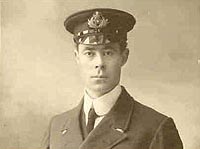
Commander Harold Godfrey Lowe, RD was a Welsh naval officer. He was also the fifth officer of the RMS Titanic, and was amongst the four of the ship's officers to survive the disaster.
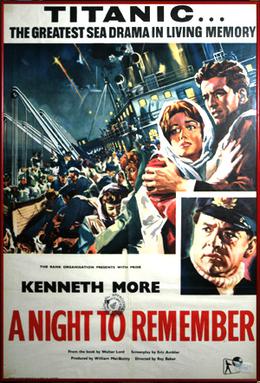
A Night to Remember is a 1958 British historical disaster docudrama film based on the eponymous 1955 book by Walter Lord. The film and book recount the final night of RMS Titanic, which sank on her maiden voyage after she struck an iceberg in 1912. Adapted by Eric Ambler and directed by Roy Ward Baker, the film stars Kenneth More as the ship's Second Officer Charles Lightoller and features Michael Goodliffe, Laurence Naismith, Kenneth Griffith, David McCallum and Tucker McGuire. It was filmed in the United Kingdom and tells the story of the sinking, portraying the main incidents and players in a documentary-style fashion with considerable attention to detail. The production team, supervised by producer William MacQuitty used blueprints of the ship to create authentic sets, while Fourth Officer Joseph Boxhall and ex-Cunard Commodore Harry Grattidge worked as technical advisors on the film. Its estimated budget of up to £600,000 was exceptional and made it the most expensive film ever made in Britain up to that time. The film's score was written by William Alwyn.

Titanic: The Long Night is a 1998 romance novel by Diane Hoh. It is an entirely fictional story set aboard the real ship, the Titanic.

RMS Titanic sank in the early morning hours of 15 April 1912 in the North Atlantic Ocean, four days into her maiden voyage from Southampton to New York City. The largest ocean liner in service at the time, Titanic had an estimated 2,224 people on board when she struck an iceberg at around 23:40 on Sunday, 14 April 1912. Her sinking two hours and forty minutes later at 02:20 ship's time on Monday, 15 April, resulted in the deaths of more than 1,500 people, making it one of the deadliest peacetime maritime disasters in history.
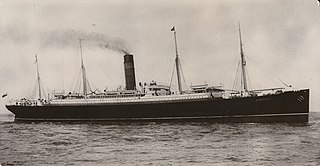
RMS Carpathia was a Cunard Line transatlantic passenger steamship built by Swan Hunter & Wigham Richardson in their shipyard in Wallsend, England.
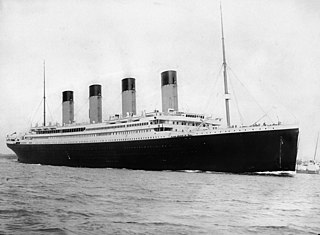
RMS Titanic was a British passenger liner, operated by the White Star Line, that sank in the North Atlantic Ocean on 15 April 1912 as a result of striking an iceberg during her maiden voyage from Southampton, England, to New York City, United States. Of the estimated 2,224 passengers and crew aboard, more than 1,500 died, making it the deadliest sinking of a single ship up to that time. It remains the deadliest peacetime sinking of an ocean liner or cruise ship. The disaster drew public attention, spurred major changes in maritime safety regulations, and inspired many artistic works.
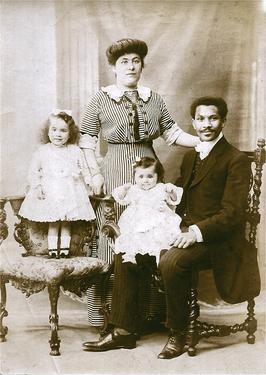
Joseph Philippe Lemercier Laroche was a Haitian engineer. He was one of only three passengers of known Haitian ancestry on the ill-fated voyage of RMS Titanic.
Emily Maria Borie Ryerson was an American first-class passenger who survived the sinking of RMS Titanic on April 15, 1912.
Vanished, also known as Danielle Steel's Vanished, is a 1995 American made-for-television romantic drama film directed by George Kaczender and starring George Hamilton, Robert Hays and Lisa Rinna. The film is based on the 1993 novel of the same name by Danielle Steel.

No Greater Love is a novel by Danielle Steel. It tells a fictional story based on the true event of the sinking of the RMS Titanic. It is Steel's 28th novel.

Titanic Lifeboat No. 1 was a lifeboat from the steamship Titanic. It was the fifth boat launched to sea, over an hour after the liner collided with an iceberg and began sinking on 14 April 1912. With a capacity of 40 people, it was launched with only 12 aboard, the fewest to escape in any one boat that night.

Lifeboats played a crucial role during the sinking of the Titanic on 14–15 April 1912. The ship had 20 lifeboats that, in total, could accommodate 1,178 people, a little over half of the 2,209 on board the night it sank.

Dickinson H. Bishop was an American businessman who traveled on board the ill-fated maiden voyage of the RMS Titanic while on his honeymoon with bride Helen, née Walton. They both survived the sinking of the Titanic on 15 April 1912.
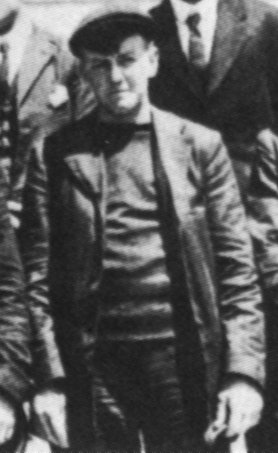
George Thomas Macdonald Symons was a British sailor who worked as a lookout on board the ill-fated RMS Titanic. Symons, who was 24 at the time of the sinking of the ship, was put in charge of one of the first lifeboats to be launched, lifeboat #1. The boat was an emergency cutter which was launched with only 12 people on board, including seven crew members, and had gained notoriety after the disaster.


















